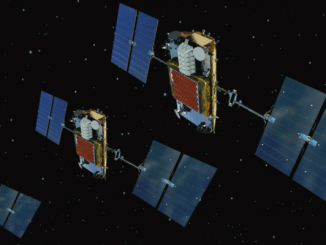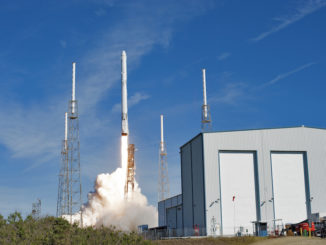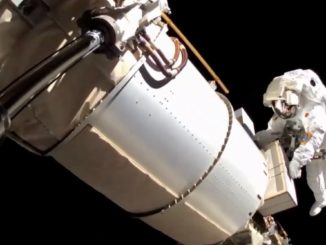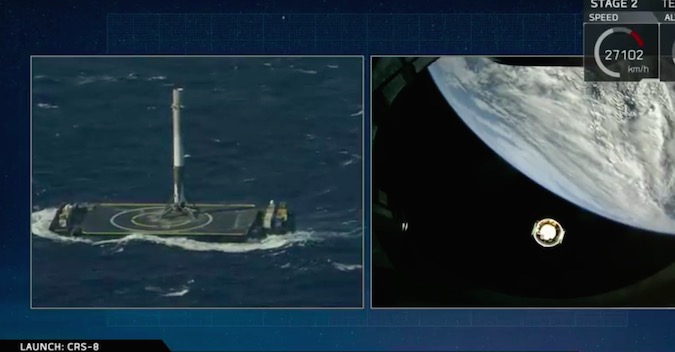
A SpaceX Falcon 9 rocket booster descended under engine power to a floating landing platform in the Atlantic Ocean on Friday, notching the first-ever rocket landing at sea minutes after liftoff from Cape Canaveral with a supply ship hauling 3.5 tons of cargo to the International Space Station.
The dramatic landing, broadcast live by SpaceX and NASA, is the latest achievement for the commercial space transportation company led by Elon Musk, who aims to make rocket launches less expensive to enable his vision of affordable human missions to Mars.
It was the fifth time SpaceX has tried to recover a spent Falcon 9 first stage on an ocean-going ship. The previous four tries were unsuccessful, with the rocket coming down too fast or tipping over after touchdown.
Friday’s landing hit the mark, with the rocket settling down on four landing legs aboard the landing platform named “Of Course I Still Love You.”
“‘Of Course I Still Love You,’ we have a Falcon 9 on-board,” a SpaceX engineer announced on the flight radio loop.
Touchdown occurred about 8 minutes, 35 seconds, after the Falcon 9 blasted off from Cape Canaveral’s Complex 40 launch pad at 4:43:31 p.m. EDT (2043:31 GMT) with a commercial Dragon cargo capsule heading for the space station.
The first stage came back to Earth with a sequence of three rocket burns — the first two with three engines, then with one engine — as the Falcon 9’s second stage accelerated into orbit with the Dragon spacecraft.
A split-screen video feed provided by SpaceX followed the independent rocket flights at the same time, showing the first stage touching down as the Dragon spaceship soared nearly 150 miles over the Atlantic Ocean in orbit.
The landing barge used underwater engines to precisely hold position about 185 miles (300 kilometers) northeast of Cape Canaveral. Periodic waves gave the platform a tilt of up to 2 or 3 degrees, and the rocket battled stiff winds on final approach to the ship, officials said.
SpaceX has recovered one of its rockets before. In December, a Falcon 9 booster stage returned to a landing zone at Cape Canaveral a few miles from its launch pad.
Friday’s successful descent to the landing platform, dubbed a drone ship by SpaceX, was the first time a space launcher returned to Earth at sea.
The achievement is important because SpaceX hopes to reuse Falcon 9 first stage boosters to reduce the cost of space transportation, and launches carrying heavy payloads to high-altitude orbits are going too fast and need too much fuel for the rockets to turn around and head back for land.
Rockets on those missions — accounting about half of the Falcon 9’s future manifest — must arc downrange from the launch site and target landings hundreds of miles away.
“I think it’s another step towards the stars,” Musk said after Friday’s launch and landing. “In order for us to really open up access to space, we’ve got to achieve full and rapid reusability, and being able to do that for the primary rocket booster is going to be a huge impact on cost.”
Landing the rocket at sea is easier on the first stage’s fuel margins, but it is technically more daunting than steering back toward shore.
“It’s sort of like an (aircraft) carrier landing vs. a land landing,” Musk said. “It’s a tinier spot, and it’s moving.”
Onboard view of landing in high winds pic.twitter.com/FedRzjYYyQ
— SpaceX (@SpaceX) April 9, 2016
SpaceX technicians stationed on a boat near the drone ship planned to weld steel shoes over the rocket’s four carbon fiber and aluminum landing legs to keep the 156-foot-tall stage from tipping over.
The recovery crew will safe the rocket, drain it of hazardous fluids and gases, and set course for Port Canaveral, the drone ship’s home base. Musk said the vessel is due to arrive some time Sunday.
Once it is back in port, ground teams will retract the booster’s landing legs, rotate it horizontal and drive it to a SpaceX facility at nearby Cape Canaveral — likely launch pad 39A at Kennedy Space Center — for hotfire tests, Musk said.
“Our plan is to basically fire it 10 times in a row on the ground,” Musk said. “If things look good at that point, then it’s qualified for reuse and launch. We’re hoping to re-launch on an orbital mission probably around … June.”
The first stage recovered by SpaceX in December is set to go on display outside the company’s headquarters in Hawthorne, California, later this year, Musk said.
Musk said he expects the launch of the previously-flown booster will have a paying customer, but he declined to identify which client might put their payload on the rocket.
SpaceX and satellite industry officials have said a demonstration launch is not required if the used rocket stage is proven flight-ready in ground tests.
Gwynne Shotwell, SpaceX’s president and chief operating officer, said last month the company plans to discount flights with previously-flown first stage boosters by up to 30 percent — equivalent to approximately $40 million compared to the Falcon 9’s current commercial price of $61.2 million.
That’s with a new second stage and payload fairing on each flight.
SpaceX is working on recovering the Falcon 9’s clamshell-like nose cone after launches. If achieved, that would offer savings on the order of several million dollars, according to Musk.
There is no near-term plan to get the Falcon 9’s upper stage back. That piece enters orbit on each launch and would need a cumbersome heat shield to survive the journey back into Earth’s atmosphere at a velocity of 5 miles per second.
The reuse emphasis now is on recovering the Falcon 9’s first stage, and the strap-on boosters aboard SpaceX’s Falcon Heavy rocket, which is set to debut at the end of this year.
The Falcon Heavy is made of three Falcon 9 first stage cores bolted together, giving the behemoth launcher 27 Merlin engines to power it off the ground.
“It’ll still take us a few years to make (landings) smooth and make it efficient, but I think it’s proven that it can work,” Musk said. “There probably will be some failures in the future, but we’ll iron those out and get to the point where it’s routine to bring it back, and where the only change to the rocket is to maybe hose it down and clean it, give it a wash, and add the propellant and fly again.”
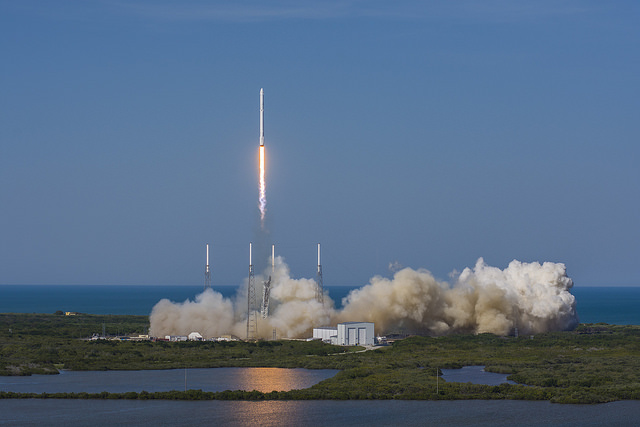
President Obama congratulated SpaceX on the landing in a tweet: “Congrats SpaceX on landing a rocket at sea. It’s because of innovators like you & NASA that America continues to lead in space exploration.”
SpaceX’s path to landing its rocket components has been rocky, marred by unsuccessful bids to get boosters back via parachute before a switch to the powered descent recovery mode. Musk’s company also got into a patent dispute with Blue Origin, a rival commercial space firm established by Amazon.com’s Jeff Bezos, over the barge landing scheme.
Wayne Hale, a respected former NASA space shuttle program manager and now an aerospace industry consultant, noted the widespread skepticism often given SpaceX since the reusability plan went public: “And they said it couldn’t be done (at least no one has ever done it) until, of course, you did it.”
Dragon on track for space station
As for the prime purpose of Friday’s launch, the Dragon cargo craft set off on a one-and-a-half day pursuit of the space station after its deploying from the Falcon 9’s second stage.
The gumdrop-shaped capsule deployed from the rocket about 10 minutes after liftoff — moments after the first stage landing — and the Dragon’s two power-generating solar panels unfurled to a span of 54 feet (16.5 meters).
Hans Koenigsmann, SpaceX’s vice president of flight reliability, told reporters Friday night that the capsule is in good health. A door covering the spacecraft’s grapple fixture and navigation sensors opened up a few hours after launch in one of the supply mission’s early milestones.
“We’re very excited to have our cargo, and the Dragon, safely on orbit, and we’re very much looking forward to it arriving to the ISS,” said Kirk Shireman, NASA’s space station program manager.
A tightly-choreographed flight plan Saturday calls for several firings of the ship’s thrusters to adjust its orbit and approach the space station.
The cargo freighter, packed with 6,913 pounds (3,136 kilograms) of equipment, will complete a laser-guided final rendezvous with the research complex, approaching from underneath in the predawn hours Sunday, U.S. time.
European Space Agency flight engineer Tim Peake will take control of the space station’s 58-foot-long robotic arm to grapple the Dragon spacecraft around 7:12 a.m. EDT (1112 GMT).
The robot arm will maneuver the capsule to an attach point on the Harmony module a few hours later, where it will stay until May 11.
The mission is SpaceX’s eighth of at least 26 operational supply deliveries to the space station, and the company’s first visit to the complex in a year after a launch failure grounded the Falcon 9 rocket.
NASA has also contracted with Orbital ATK and Sierra Nevada Corp. for space station cargo services, sharing the load with Russian and Japanese logistics carriers.
Stowed inside the Dragon capsule’s unpressurized trunk is the Bigelow Expandable Activity Module, or BEAM, a soft-sided room built to demonstrate inflatable habitats for commercial space stations and long-distance deep space voyages.
The International Space Station’s robotic arm will pluck BEAM from Dragon’s external cargo carrier April 16 and place it on a berthing port on the outpost’s Tranquility module.
The module is tightly packed for launch, but it will extend and balloon open to a volume of 565 cubic feet (16 cubic meters) — four times its current size — around May 26 after several weeks of thermal stabilization.
Developed by Las Vegas-based Bigelow Aerospace under a $17.8 million contract with NASA, the structure will spend two years on the space station to test its resilience to the harsh temperature swings of low Earth orbit and impacts by micrometeoroids and space debris.
Astronauts will enter the module to install sensors and periodically retrieve data cards for analysis by engineers on the ground.
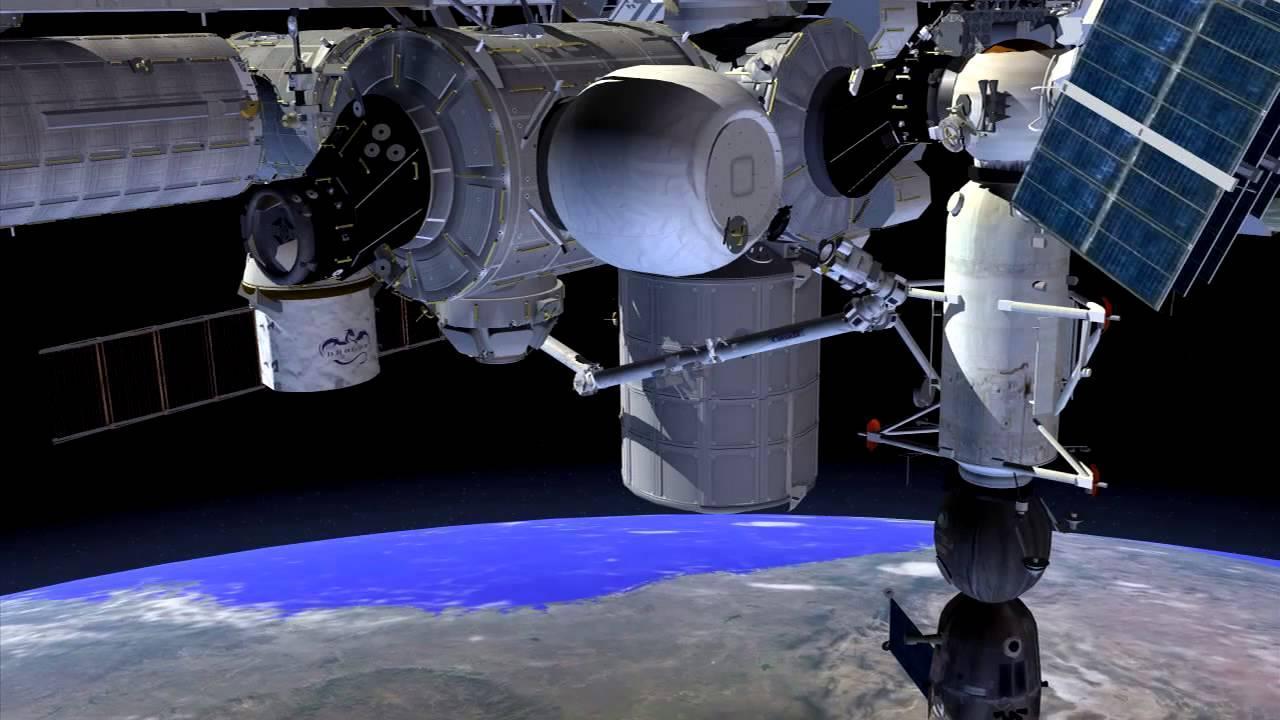
The station crew will unpack nearly 3,800 pounds (1,723 kilograms) of supplies, provisions and experiments inside Dragon’s internal compartment.
The spaceship’s cargo manifest includes:
- BEAM — 3,115 pounds (1,413 kilograms)
- Science Investigations — 1,410 pounds (640 kilograms)
- Crew Supplies — 1,205 pounds (547 kilograms)
- Vehicle Hardware — 674 pounds (306 kilograms)
- Spacewalk Equipment — 26 pounds (12 kilograms)
- Computer Resources — 238 pounds (108 kilograms)
- Russian Hardware — 72 pounds (33 kilograms)
The experiments aboard Dragon include 20 female mice for an experiment developed by Eli Lilly, the Indiana-based pharmaceutical firm, to investigate how an antibody made in the company’s laboratories might inhibit muscle loss.
“This experiment has implications for spaceflight and longer-term space missions, but for us, the interest is because of patients on Earth who have muscle-wasting diseases,” said Rosamund Smith, Eli Lilly’s principal investigator for the muscle atrophy experiment. “This can be things ranging from ALS, muscular dystrophy, some types of cancer and even the frail elderly undergo muscle-wasting, and there are many similarities between the muscle-wasting that occurs on Earth in those disaseaes and that (which) occurs in space.”
Astronauts will help collect data on the function of the mice’s muscles, then euthanize the specimens and prepare tissue samples for return to Earth aboard the Dragon spacecraft when it comes home.
The returning Dragon will also come back with blood and urine samples collected from astronaut Scott Kelly, who completed a nearly year-long expedition on the space station in early March. The samples have waited for SpaceX’s supply ship to arrive because Dragon is the only spacecraft capable of bringing significant cargo from the space station back to Earth.
NASA hopes to study how the 340-day mission affected Kelly’s physiology in preparation for even longer voyages to Mars.
Dragon will parachute to a splashdown in the Pacific Ocean on May 11.
SpaceX’s next launch is scheduled for around April 28 with Japan’s JCSAT 14 television broadcasting satellite.
Email the author.
Follow Stephen Clark on Twitter: @StephenClark1.

